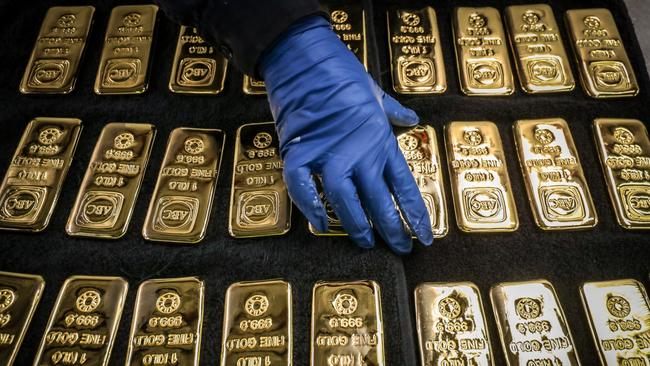Inflation fears spur new gold rush
Australians have bought 25 per cent more gold this year to date – will it make sense?

Gold bugs have long touted the yellow metal’s role as an inflation hedge. But with central banks on the attack over spiralling prices, the big question for investors is whether to buy now or wait to see how the tug of war plays out.
Gold surged in March as the Russia-Ukraine war erupted, climbing above $US2000 an ounce, just shy of its 2020 all-time high. After trading sideways for a few weeks, the price pushed higher again earlier in April, before dropping back below $US1900 this week.
The conflicting forces pulling the precious metal in opposing directions are inflation and higher rates. If central banks can’t get a lid on inflation, gold should push higher. But if the US Federal Reserve and its peers can contain prices, gold loses its lustre.
Ultimately, investors need to work out where they sit in the central bank versus inflation fight, BetaShares chief economist David Bassanese says.
“Gold is a good hedge against high and sustained inflation, as we saw in the 1970s. But the best hedge against inflation is central banks doing their job,” Bassanese says. “Markets at the moment are thinking that central banks are going to do their job – that they’ll raise rates and contain inflation.
“But if you fear high and sustained inflation, if you think central banks actually aren’t going to be able to contain inflation and we’re headed back to a 1970s-style period, then gold is going to be a good hedge in that environment – gold should really benefit in that scenario.”
The market is conflicted about the outlook for the precious metal, he says.
“Gold rallied when Russia invaded Ukraine and now it’s pulled back again because we’ve seen central banks, particularly the US Federal Reserve, get quite aggressive in talking about raising interest rates,” he says.
“At the same time, the US dollar has gone up as well since early March. So rising bond yields and a rising US dollar have taken the edge off gold in recent weeks.”
Even with this murky outlook, Australians have stepped up their demand for gold in the first months of the year, according to a report from the World Gold Council released this week.
Indeed, Australians bought 8.9 tonnes of physical gold in the three months to the end of March – a 24 per cent jump on the same period last year.
Demand for gold jewellery rose a sharp 40 per cent to 2.7 tonnes over the quarter, while demand for gold bars and coins was up 19 per cent at 6.2 tonnes.
Australia has “bucked the trend” in its rush for gold, says the regional chief executive of the World Gold Council, Andrew Naylor.
Local investors – both retail and institutional – are also pumping money into the yellow metal through ASX-listed exchange-traded funds such as ETF Securities’ Physical Gold ETF (ASX: GOLD), which has seen net inflows of close to $150m in the year to date, including $60m in March and $40m in April.
Gold ETFs offer low-cost access to physical bullion via the stock exchange, without the need for investors to actually store their own bars.
ETF Securities’ offering provides a return equivalent to the movements in the Australian dollar price of gold, less a daily management fee, and is backed by gold bullion held by JPMorgan Chase.
ETF Securities head of distribution Kanish Chugh says professional investors are starting to increase their allocations to gold amid the uncertain outlook.
“We’ve got a number of investors at the institutional, private wealth and investment professional level who have strategic model allocations to gold. And they’re adding to that allocation because of the geopolitical environment and the inflation,” Chugh says.
“Some significant private wealth clients were sitting with a 2-5 per cent allocation to gold in their portfolio. They’re now increasing that, they’re applying a tactical overweight at the moment to their strategic allocation.”
For some clients, the allocation to gold is pushing up to 10 per cent of portfolios, he adds.
One client has “got upwards of 15 per cent (allocated to gold). That’s obviously very bullish,” Chugh says.
BetaShares’ Gold Bullion ETF (ASX: QAU) saw a spike in inflows this week following a shock 5.1 per cent inflation print.
While the fund recorded just under $2m in net inflows for the month to April 27, a further $8m flooded in following the CPI data release on Wednesday, showing some investors are worried the Reserve Bank will not be able to get inflation under control.
The currency-hedged QAU ETF reduces the risk associated with fluctuations in Australian and US dollars, BetaShares CEO Alex Vynokur notes.
“QAU gives investors exposure to gold while mitigating currency risk – a relevant point in an environment where inflation and interest rates are both predicted to increase,” he says.
Certainly, as a defensive asset, gold is doing its job so far this year: the gold price is in positive territory year to date, compared to US markets, which are down between 9 per cent and 20 per cent. Even the ASX 200 moved into negative territory this week.
But if inflation gets out of control, gold may indeed have quite a bit of lustre.




To join the conversation, please log in. Don't have an account? Register
Join the conversation, you are commenting as Logout